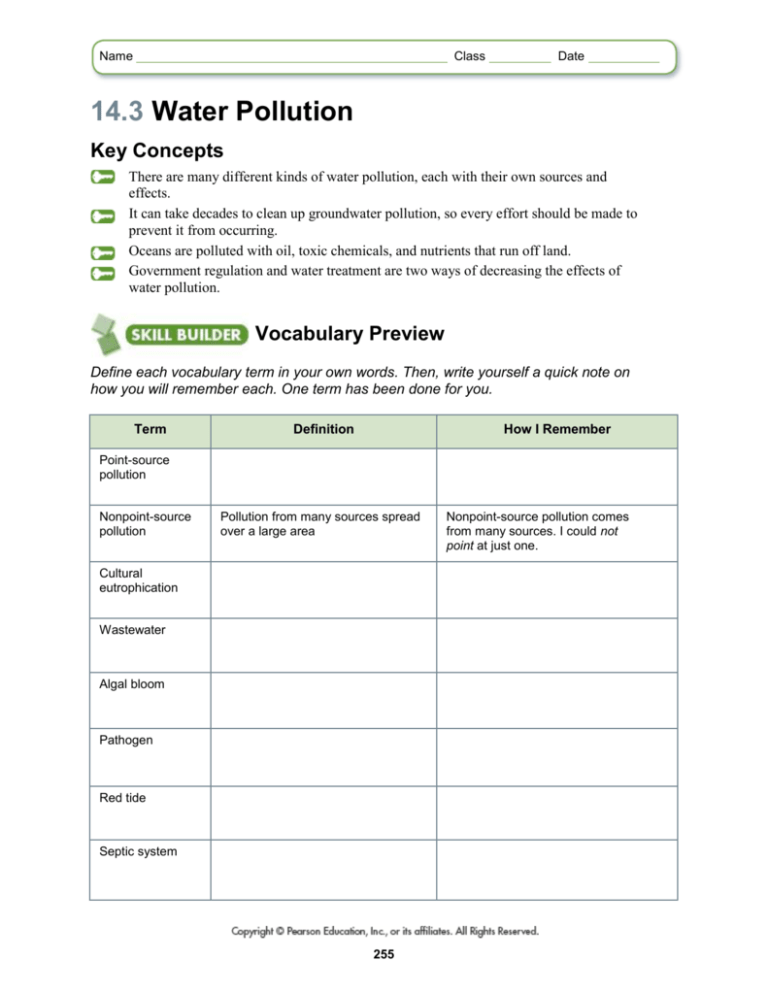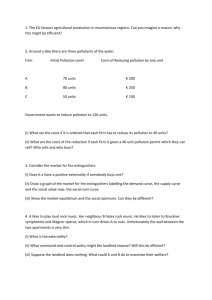Ocean Water Pollution
advertisement

Name Class Date 14.3 Water Pollution Key Concepts There are many different kinds of water pollution, each with their own sources and effects. It can take decades to clean up groundwater pollution, so every effort should be made to prevent it from occurring. Oceans are polluted with oil, toxic chemicals, and nutrients that run off land. Government regulation and water treatment are two ways of decreasing the effects of water pollution. Vocabulary Preview Define each vocabulary term in your own words. Then, write yourself a quick note on how you will remember each. One term has been done for you. Term Definition How I Remember Point-source pollution Nonpoint-source pollution Pollution from many sources spread over a large area Cultural eutrophication Wastewater Algal bloom Pathogen Red tide Septic system 255 Nonpoint-source pollution comes from many sources. I could not point at just one. Name Class Reading Strategy As you read the lesson, complete the main ideas and details chart. Main Ideas Details Types of water pollution Groundwater pollution Ocean water pollution Controlling water pollution 256 Date Name Class Date Types of Water Pollution For Questions 1–5, match each type of pollution with the statement that best describes it. 1. nutrient pollution 2. toxic chemical pollution a. includes disease-causing agents in the water b. caused by erosion c. raises the temperature of the water 3. sediment pollution d. can cause cultural eutrophication 4. thermal pollution e. includes heavy metals and toxic organic chemicals 5. biological pollution 6. Fill in the flowchart with the terms increase(s) and decrease(s) to model the process of eutrophication. Water nutrient levels Aquatic plant growth Decomposition Dissolved oxygen levels Groundwater Pollution For Questions 7–11, write True if the statement is true. If the statement is false, replace the underlined word or words to make the statement true. Write your changes on the line. 7. Groundwater pollution is easy to monitor and clean up. 8. Groundwater pollution as a result of human activity is widespread. 9. Pollutants leach through soil and seep into storage tanks. 10. It can take decades for groundwater to get rid of its contaminants. 11. Most efforts to reduce groundwater pollution focus on prevention. Ocean Water Pollution 12. Why is it important to minimize the amount of oil released into the ocean? 13. What is the largest source of oil in the oceans? 14. Why is mercury contamination in the ocean a concern? 257 Name Class Date 15. What causes red tides? For Questions 16–19, write True if the statement is true. If the statement is false, replace the underlined word or words to make the statement true. Write your changes on the line. 16. Most oil pollution in the oceans comes from small, nonpoint sources. 17. Marine organisms at higher trophic levels contain higher levels of mercury. 18. Of the nutrients phosphorus and nitrogen, phosphorous causes the most damage to oceans. 19. Reducing oil seepage into coastal waters can lessen the frequency of algal blooms. Controlling Water Pollution Complete each statement by writing the correct word or words. 20. The Clean Water Act made it illegal to release without a permit. 21. Drinking water suppliers filters before sending it to your tap. 22. from a point source water with chemicals and run it through includes water from showers, toilets, dishwashers, as well as water used by industry to cool power plants. Answer the questions to test your knowledge of lesson concepts. You can check your work using the answers on the bottom of the page. 23. List two types of water pollution. 24. Describe how The Clean Water Act has reduced point-source pollution in the U.S. 258






